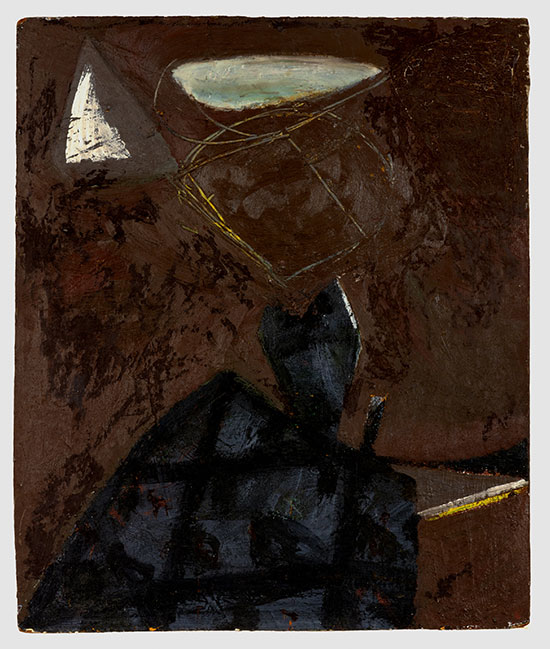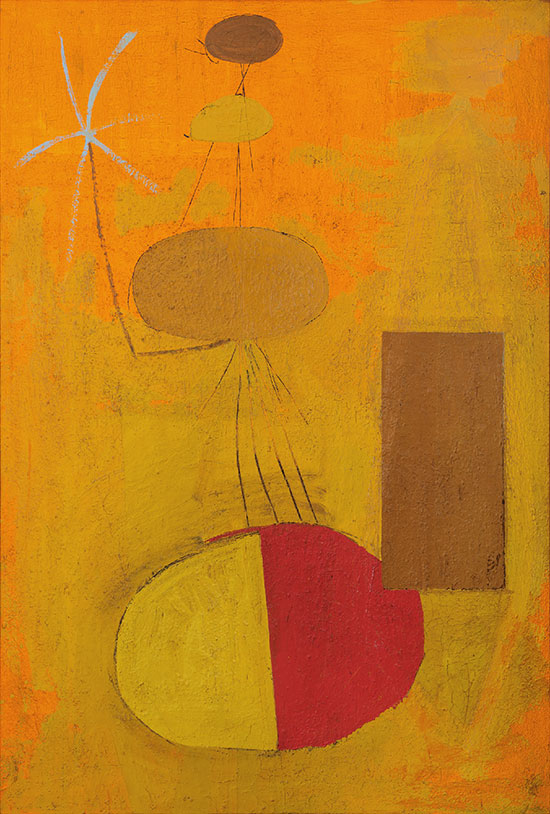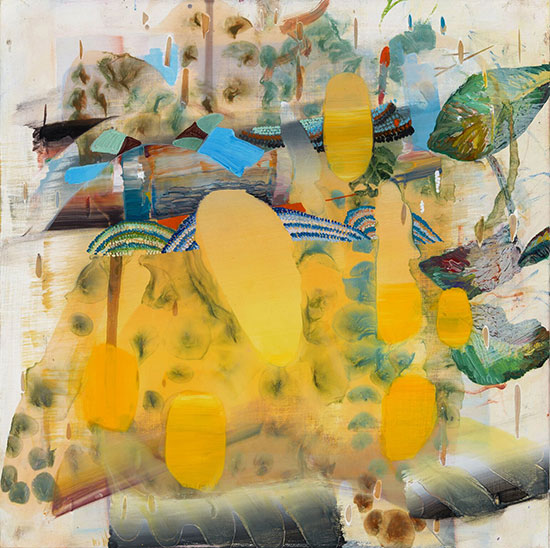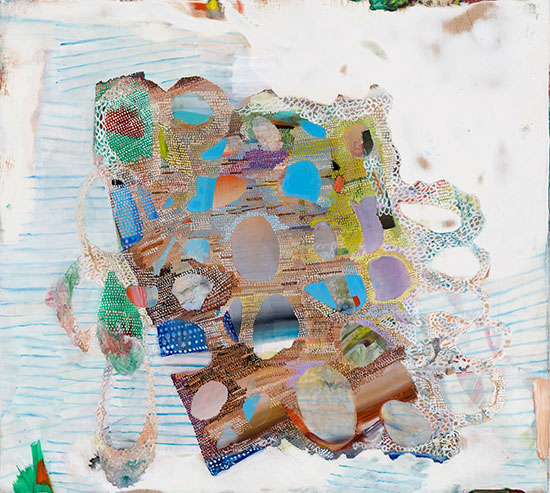“Homemade Tattoo,” the second exhibition of paintings by Carolyn Case at Asya Geisberg Gallery in Chelsea, marks my introduction to the work of a promising artist whose first show at Geisberg back in 2015 I had missed. This is not an unusual occurrence. There is more gathering than hunting in an art critic’s work day and, as one cannot see everything, missed opportunities are at least as typical as chance encounters.
This time, chance led me to a pair of related discoveries. Not only did it lead me to wander casually into Case’s show, but it did so at a time when I had just left a Robert Motherwell exhibition at the Paul Kasmin Gallery. The seminal paintings by Robert Motherwell on view, mostly from the 1940s, highlighted for me an aspect of his work that set me up to catch something in Case’s work I might otherwise have missed.
And, to carry the theme of chance just a bit further, the Motherwell exhibition also demonstrated for me how a voracious art-market appetite for work of unquestioned pedigree can, on rare occasions, provide access to lesser known pieces that refresh the historical record in a meaningful way.
What stood out in the early Motherwells at Kasmin was the ruthlessness with which they had been reworked. Layers of previous activity can be seen, for instance, beneath the surface of The Dark Lady, 1947/85, that are visible yet not convincingly appropriated into the painting’s completion—not even in the very late revision as reflected in the double date. Not-so-faint traces of earlier markings in The Dark Lady seemed like footprints one would read on an abandoned trail. In another example, clumps of dried pigment beneath the flat ochre field in Orange Personage, 1947, distend through the surface like scar tissue, and as such imply that they are to be politely ignored.
.

"The Dark Lady" by Robert Motherwell. © Dedalus Foundation, Inc. / Licensed by VAGA, New York, NY.
.

"Orange Personage" by Robert Motherwell. © Dedalus Foundation, Inc. / Licensed by VAGA, New York, NY.
.
Art historians and devotees of the artist know, of course, that Motherwell’s goal, despite all the reworking, was not accumulation, but finding the stroke that made previous strokes extraneous—an aesthetic that peaked in the elegant candor of his mature work. The Kasmin exhibition makes clear that even in his early work, Motherwell demonstrated an unapologetic faith in spontaneity. And with this observation still fresh in my mind, I found myself standing before Carolyn Case’s painting on wood (from which the show’s title is derived) Homemade Tattoo, 2017, and immediately noticed that her attitude toward reworking a painting differed radically from Motherwell’s.
.

"Homemade Tattoo" by Carolyn Case, 2017. Oil on panel, 42 x 50 inches. Courtesy of Asya Geisberg Gallery.
.
In a Case painting, prior activity never looks abandoned or buried. Layers representing many painting sessions are repaired, re-contextualized, enhanced or subsumed into other imagery. In contrast to what Motherwell was doing, Case’s approach reveals a deep skepticism toward spontaneity as a reliable endgame. The comparison is quite stark. Intense revision for Case is a preordained routine that is fundamental to painting itself, an attitude that not only downgrades surrealist automatism but meets spontaneity—an inevitable property of any abstract painting method—with suspicion.
Case’s 42” x 50” Homemade Tattoo, 2017, consists of a central cluster of cell-like ellipses framed by open space, a space intruded upon at the frame’s edges by larger rounded shapes cropped as if the field extended indefinitely. Within a dominant white, some of which is the ground itself, color is dispersed through vignettes of painterly overlaps that draw the viewer close to the surface. The incorporation of areas painted earlier tend to be intimate in scale and best viewed up close.
Though the panel is more than four feet wide, much of its charm requires getting as close to the surface as one would typically get to a smaller piece. At this range, the viewer can appreciate Paul Klee-like patterns made of many dots arranged in loosely defined grid structures that serve here and there as floating screens laid over previously brushed or wiped areas.
Case’s work remains largely abstract, but not dogmatically so. References to nature, landscape and familiar objects occasionally emerge. Recognition of several fastidiously painted leaves on the right side of the panel entitled Sunset, 2017, endorse the title’s overt reference to landscape, while the more subtle shapes of glowing yellow gradations merely hint at a setting sun. In several paintings, loosely rendered fragments of note paper, the kind with binder holes and pale blue lines, struck me as related to the process of returning to the painting as a routine, and adding additional changes and new ideas the same way a diarist sits with blank pages and fills them on a regular basis.
.

"Sunset" by Carolyn Case, 2017. Oil on panel, 12 x 12 inches. Courtesy of Asya Geisberg Gallery.
.
Caution and patience are certainly hallmarks of her method, but so too are a few drastic techniques, like her use of an orbital sander to take a region of a panel painting down to the wood base. In most areas, additive methods are used to highlight an interesting drip, gesture or cluster of overlapping layers. But Meditation Mind, 2017, has its entire upper right quadrant sanded down to patches of white ground and wood, leaving a cloud or fog effect, which is then incorporated into the light tonality that all of Case’s panels share. It is as if the prepared white ground is treated not as a field of activity, but as the first stage of a multi-stage process.
.

"Meditation Mind" by Carolyn Case, 2017. Oil on panel, 18 x 20 inches. Courtesy of Asya Geisberg Gallery.
.
The unique composition that emerges in each painting is as much a product of her intuitive method as are the smaller details. Despite the complex process of realization, her work holds together both in the inventively individual panels and as a coherent group expressing a singular sensibility. In other words, what may seem at first an overworked and extra-cautious process delivers an enthusiastic celebration of open-ended thinking and makes a compelling argument for the liberating qualities of second thoughts.
The appeal of spontaneity for the artists like Motherwell emerging in the 1940s was inseparable from its potential to attach great meaning to intimate personal expression, which was nothing less than the zeitgeist of the period. As Daniel Belgrad’s study, “The Culture of Spontaneity,” explains:
“The formal triumph of gesture-field painting lay in its capacity to translate issues of broad social significance into problems internal to the act of painting. A radical conception of human subjectivity was embodied in the process of composition itself, enabling painters to produce works in which personal expression and cultural critique were condensed onto the single act of painting.”
Yet that moment was but a segment in the longer history of modernism. Unfortunately, what AbEx also left behind as a part of its legacy was the painter-as-genius persona, which in turn evolved into a popular trope grounded narrowly on the histrionics of the AbEx movement, not its substance. Barely scrutinized assertions presented as synonymous with meaning continue today in a variety of genres, from the paintings of Josh Smith to the installations of Tracy Emin.
In contrast to those like Smith and Emin who promulgate an unshakable faith in spontaneity and the infallibility of an artist’s gesture, painters like Case share an unassuming and skeptical attitude toward the unplanned mark. For them spontaneity is a tool, not a tenet of faith. They rely on patient judgment and revision rather than brash assertion, and in doing so represent a more promising continuation of the experiments that defined painting as the New York School understood it.
__________________________
BASIC FACTS: “Carolyn Case: Homemade Tattoo” is on view September 7 to October 14, 2017 at Asya Geisberg Gallery, 537B W 23rd Street, New York, NY 10011. www.asyageisberggallery.com
“Robert Motherwell: Early Paintings” is on view September 7 to October 28, 2017 at Paul Kasmin Gallery, 293 Tenth Avenue, New York, NY 10001. www.paulkasmingallery.com
___________________________
Copyright 2017 Hamptons Art Hub LLC. All rights reserved.
